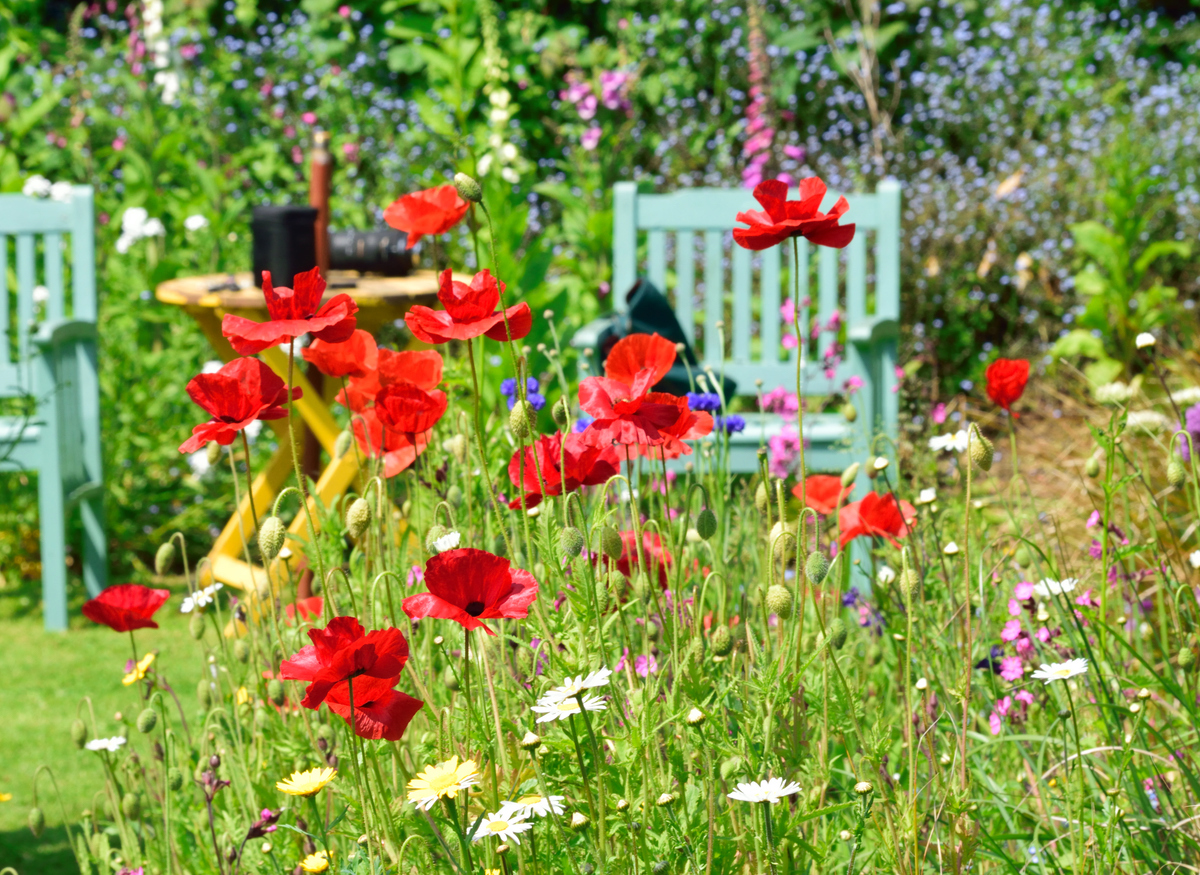

We may earn revenue from the products available on this page and participate in affiliate programs. Learn More ›
Are all types of wildflowers native plants? According to Iowa State University, there’s a distinct difference between the two: Native plants were present in an area before people settled there, while wildflowers are native or exotic (introduced) plants that can grow, reproduce, and become established without intervention or cultivation. Additionally, wildflowers are herbaceous plants, which means they are not woody, but their stems die back each year.
Many flowers considered indigenous were actually brought overseas to North America. And many plants included in wildflower mixes are simply highly vigorous garden types. For the sake of birds and pollinators, opt for wildflower plant types that are endemic or have become so without crowding out true native wildflowers.
If you’re new to gardening and interested in flower identification, exploring the varieties of wildflowers we’ve compiled below is an exciting way to start.
1. Bee Balm (Monarda didyma)

One of the showiest native red wildflowers, this native bee balm reaches 2 to 4 feet high. Its mint-like foliage and scent are accompanied by 3- to 4-inch clusters of tubular scarlet blooms. Not picky about light, bee balm can pop up in partial shade as well as full sun and produce flowers from midsummer until early autumn. It attracts the full pollinator trifecta of hummingbirds, butterflies, and bees.
USDA Plant Hardiness Zones: 3 to 9
Best For: Due to its preference for moist conditions, this plant makes a good choice for a rain garden or bog garden.
2. Black-Eyed Susan (Rudbeckia hirta)

Considered to be one of the two most common native wildflowers in the U.S. (with the other being the annual sunflower), black-eyed Susan grows 1 to 3 feet tall with fuzzy, lance-like foliage. Its cone-shaped eye is actually dark brown rather than black, and it’s surrounded by yellow wildflower petals in 2- to 4-inch diameter flowers. The plant hosts the wavy-lined emerald moth and silvery checkerspot butterfly, and it also feeds seed-eating birds like goldfinches.
USDA Plant Hardiness Zones: 3 to 10
Best For: Although a short-lived biennial or perennial, this sun lover self-sows extensively enough to brighten up wildflower meadows for years.
3. Cardinal Flower (Lobelia cardinalis)
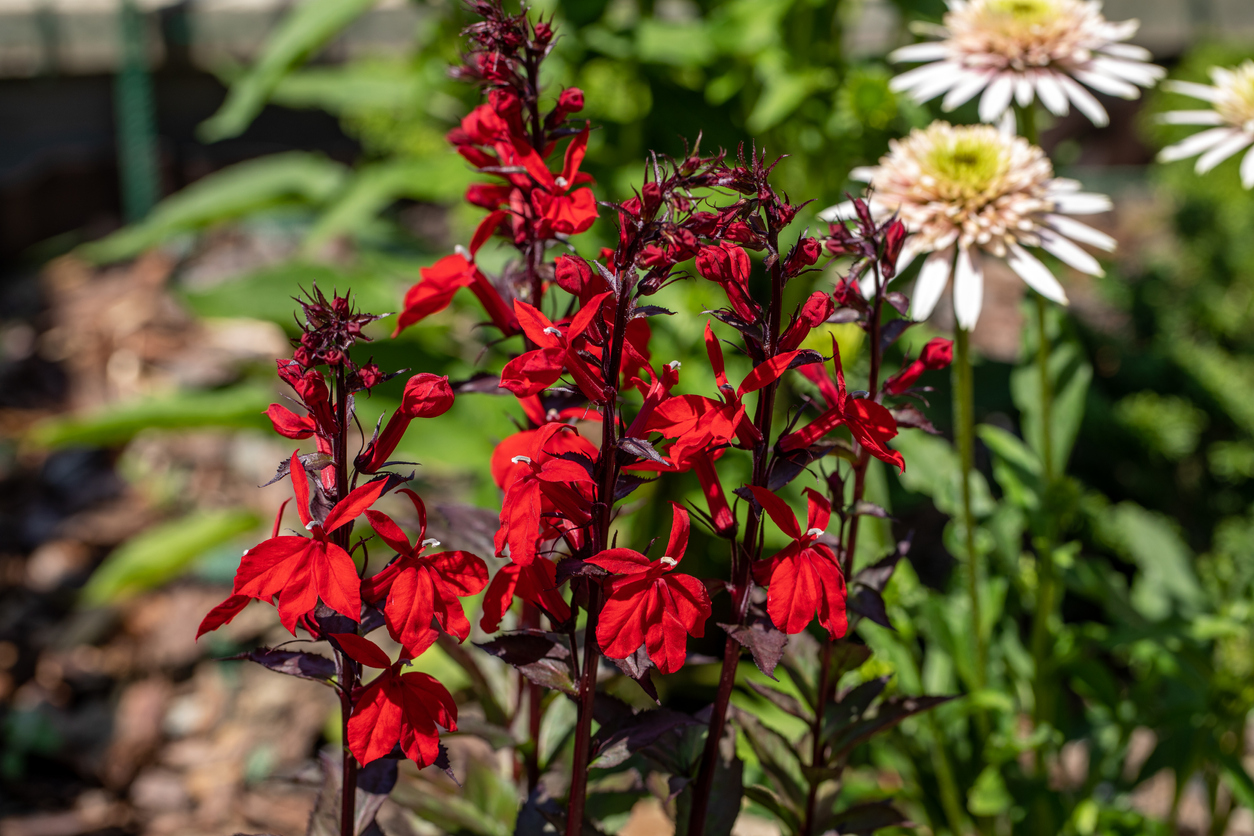
This perennial native plant shoots up to heights of 3 or 4 feet with lightly toothed foliage and spikes of red-lipped, five-lobed flowers, each about an inch long. The cardinal flower prefers partial shade but will tolerate full sun in cool climates and performs from July through September. This wildflower species is so nonaggressive that some gardeners consider it difficult to grow—but the brilliant color of its blooms attracts hummingbirds, making it well worth the bother!
USDA Plant Hardiness Zones: 3 to 9
Best For: A swamp plant by nature, this cardinal will feel right at home “nestled” in a bog or rain garden.
4. Common Evening Primrose (Oenothera biennis)

The common evening primrose has a not-so-common parlor trick of opening its blooms abruptly at dusk and closing them again in the morning. Attractive to night-flying moths for its 1- to 3-inch flowers that look and smell like lemon, it’s a biennial but self-sows heavily enough to appear perennial. Making only one rosette of leaves in its first year, it can grow 3 to 5 feet tall in its second and blooms from early summer to early autumn.
USDA Plant Hardiness Zones: 4 to 8
Best For: Thriving in full sun or partial shade, these self-seeding wildflowers can be invasive in beds but are ideal for rock gardens and wildflower meadows.
5. Common Milkweed (Asclepias syriaca)

A must-grow among the many different kinds of wildflowers for its importance to endangered monarch butterflies whose caterpillars drink its white “milk” (sap), milkweed commonly stands 3 to 5 feet tall with spherical heads of pink to purplish fragrant flowers. It blooms for most of the summer before producing pods packed with wildflower seeds. Arranged in an intricate overlapping pattern like fish scales, the seeds eventually break out to float away on their fluff. Plant milkweed not just for its buoyant seeds and butterflies, but for future generations to enjoy both down the line.
USDA Plant Hardiness Zones: 3 to 9
Best For: Blooming best in full sun, this “weed” will attract butterflies to a field of wildflowers and support monarch butterfly populations.
6. Coneflower (Echinacea purpurea)

Probably the most popular among native purple wildflowers for its medicinal qualities and 4-inch downward-daisy blooms, coneflower grows 2 to 4 feet tall. Its petals typically sweep downward, while its spiky orange and brown cone points upward. A perennial with fuzzy oblong leaves, coneflower blooms from midsummer to mid-autumn. The plant attracts beneficial soldier beetles that eat other not-so-beneficial insects, as well as finches, which feast on its seeds.
USDA Plant Hardiness Zones: 3 to 9
Best For: Equally at home in flower beds or wildflower meadows, coneflower is often considered the most resilient of summer wildflowers for its heat and drought tolerance.
7. Dogtooth Violet (Erythronium americanum)
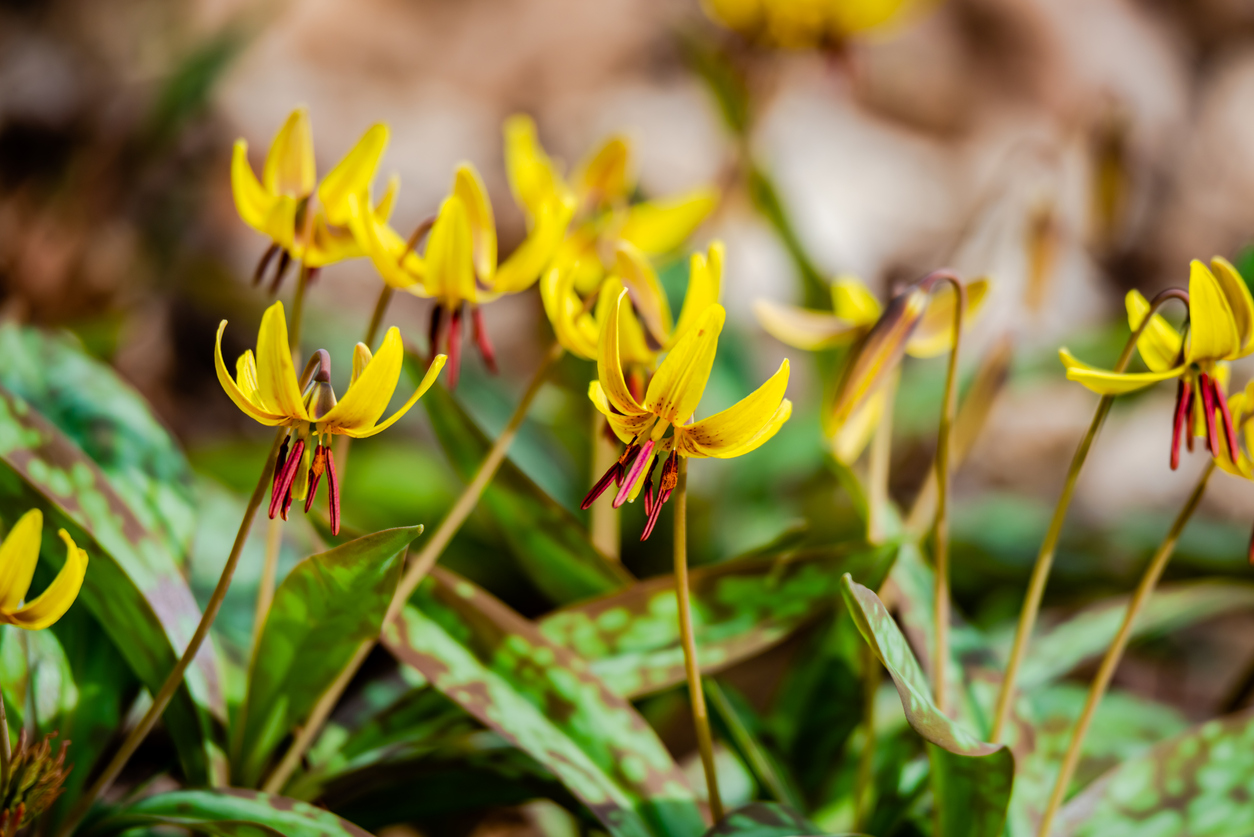
Dogtooth violets, named for the shapes of their corms, are often also called trout lilies for their green leaves’ reddish mottling. These spring wildflowers bloom before deciduous trees leaf out. Generally standing no taller than 8 inches, they produce ½-inch to 1-inch-long yellow blooms with swept-back petals resembling lilliputian lilies. These quick-growing plants die back by early summer but can provide essential early pollen for bees and a temporary attractive ground cover under trees.
USDA Plant Hardiness Zones: 3 to 8
Best For: Grow these fairy-sized “lilies” in a woodland wildflower garden or beneath deciduous trees.
8. Dooryard Violet (Viola sororia)

One of the many small wildflower plants, growing to no more than 8 inches tall with heart-shaped leaves, the native dooryard violet unfortunately has little to no scent. However, it does self-seed freely enough to make a thick ground cover in a dooryard garden or anyplace else that you choose to put it, decorated by ½- to ¾-inch pale purple blooms in spring. Keep in mind, however, that this industrious self-seeder is no shrinking violet but rather an expanding one, which probably will continue to plant itself in other locations, including your lawn.
USDA Plant Hardiness Zones: 3 to 7
Best For: Also called common blue violet, dooryard violet makes an appropriate ground cover in a woodland garden or under trees.
9. Fringed Gentian (Gentianopsis crinita)

Some of the only truly blue wildflowers, this fringed gentian grows to heights between 8 and 32 inches. From late summer to mid-autumn, it produces fringed four-petal blooms of a cerulean hue that makes a striking contrast to the warmer colors of fall leaves. Keep in mind that the plant is biennial and will make little growth during its first year. This is one of the most difficult wildflowers to grow, although it’s native throughout mountain areas of easter states.
USDA Plant Hardiness Zones: 3 to 6
Best For: This gentian prefers a moist location with alkaline soil in partial shade.
10. Ironweed (Vernonia gigantea)

Giant ironweed sports dark green leaves and generally reaches heights of 3 to 5 feet but can grow to 12 feet under favorable conditions. This bee- and butterfly-attracting native’s lavender to dark purple blooms have an aster-like shagginess, appearing in flat clusters at the top of the plant in late summer or early autumn. Each cluster contains 10 to 30 spidery florets. As the iron in their name implies, these are rugged plants that may become invasive.
USDA Plant Hardiness Zones: 5 to 8
Best For: The darkest purple ironweeds make an especially striking show at the back of a sunny flower border or moist wildflower meadow.
11. Joe Pye Weed (Eutrochium purpureum)

Also a native giant at 3 to 9 feet and one of the few flower names containing an actual name, Joe Pye grows in conditions similar to those of ironweed and often intermingled with it. However, the heads of its late summer or autumn blooms are more dome shaped, a paler purple, and rich in pollen and nectar to serve as butterfly “bait.” The plant’s foliage smells of vanilla and the plant requires a moist location, preferably in sweet rather than acidic soil.
USDA Plant Hardiness Zones: 4 to 8
Best For: This plant, too, is appropriate for the back of the border or for wildflower meadows that don’t dry out.
12. New England Aster (Symphyotrichum novae-angliae)
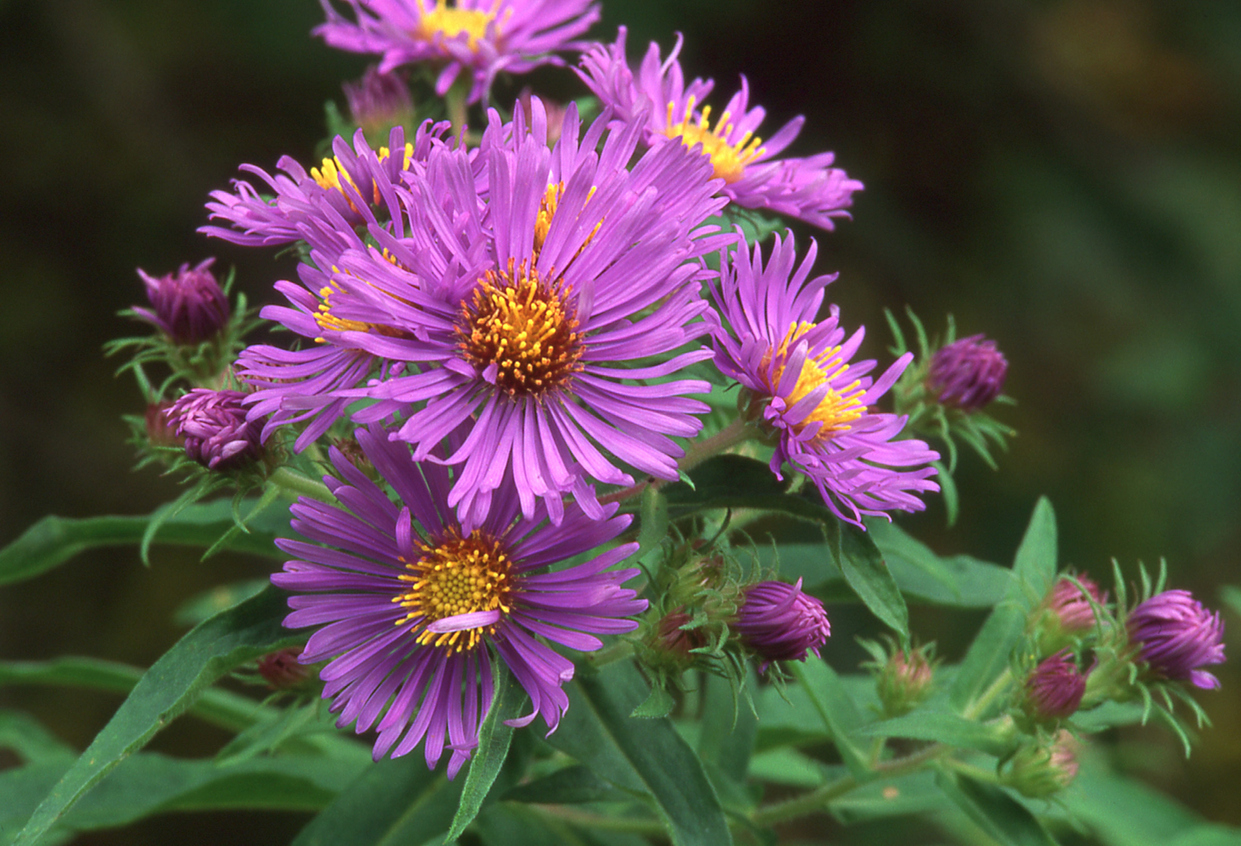
Another tall native wildflower is the New England aster. It stands between 3 and 7 feet high with turpentine-scented fuzzy leaves and 2-inch yellow-centered purple blooms appearing in late summer and autumn. (The New York aster is similar but has smoother foliage.) The New England type plays host to (meaning it feeds the larvae of) Pearl Crescent butterflies and draws in bees with its nectar, birds with its seeds, and admiring people with its blooms.
USDA Plant Hardiness Zones: 4 to 8
Best For: Due to its tolerance for wet soil, Symphyotrichum novae-angliae is a suitable rain garden plant, but also suits sunny wildflower meadows.
13. Oxeye Daisy (Leucanthemum vulgare)
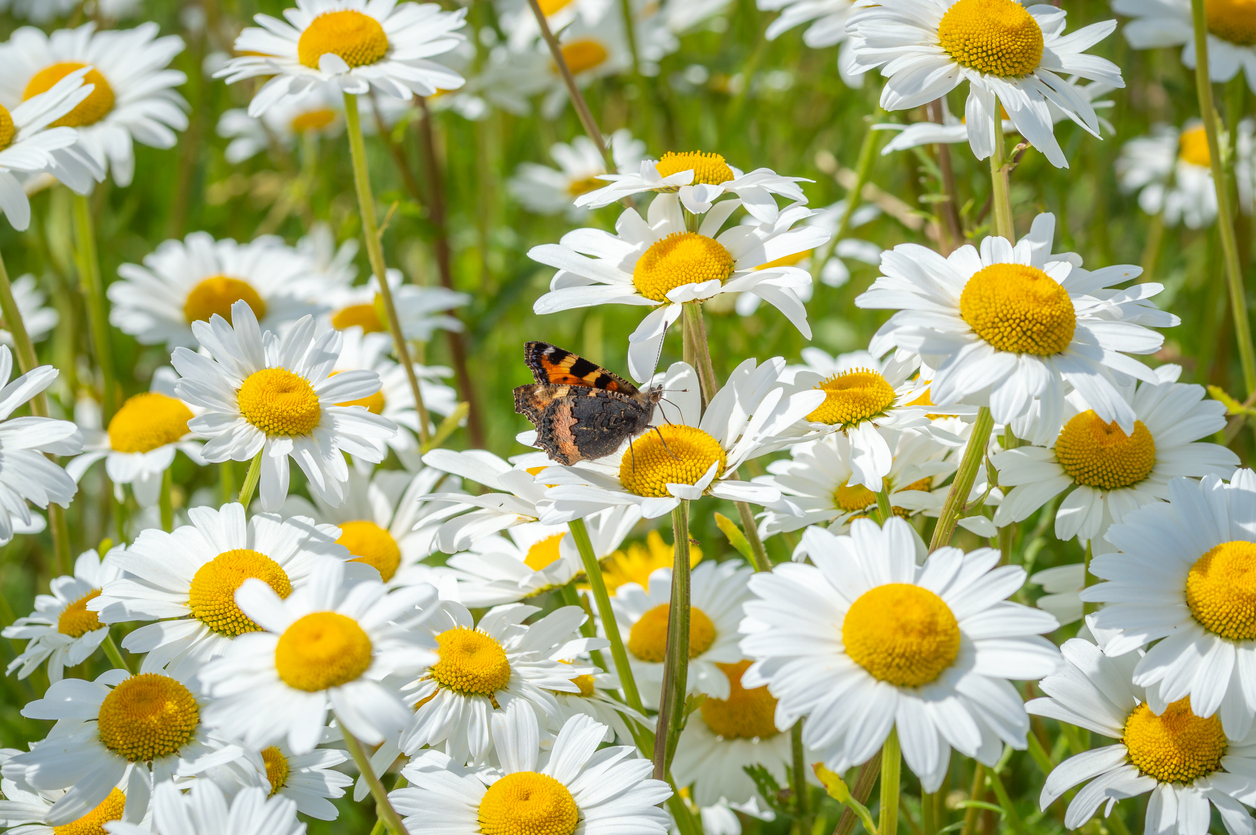
One of the U.S.’s most popular wildflowers, the oxeye daisy actually isn’t native to this country but was introduced from Europe. But the “loves-me” plant apparently loved its new location enough to settle in as if it had always lived here. Growing from 1 to 3 feet tall with lobed leaves, it features 1- to 3-inch yellow-centered blooms with white petals that appear in late spring through late summer. It is invasive enough to be considered a weed by farmers who love it not.
USDA Plant Hardiness Zones: 3 to 8
Best For: Keeping in mind its tendency to take over, you may want to plant this daisy in a wildflower meadow rather than your flower bed.
14. Prairie Gentian (Eustoma grandiflorum)

Although related to gentians, this biennial Southwestern wildflower blooms in purple rather than blue with broad gray-green leaves and cupped and comely flowers 1 to 3 inches across. Usually grown as an annual in gardens, the prairie gentian requires 5 or 6 months from seed to bloom and may revert to its biennial growth habit if conditions aren’t exactly right. Still, the flowers, with their sometimes darker purple centers, remain some of the prettiest on the prairie.
USDA Plant Hardiness Zones: 8 to 10
Best For: Prairie gentian prefers very well-draining soil with a pH between 6.5 and 7, so it often performs best in a container where its conditions can be more easily regulated.
15. Wake-Robin (Trillium grandiflorum)

Among the most unique of white wildflowers, the wake-robin grows from 1 to 1 1⁄2 feet tall and apparently is believed to rouse the robins with its mid- to late-spring blooms, composed of three overlapping white petals against a background of three broad green bracts. It is, perhaps, no surprise that the blooms tend to measure about 3 inches across. They often age to pink. When purchasing these plants, be sure that they haven’t been harvested from the wild, a practice that can set the native plants back.
USDA Plant Hardiness Zones: 4 to 8
Best For: These forest plants perform best in woodland gardens.
16. Wild Columbine (Aquilegia canadensis)
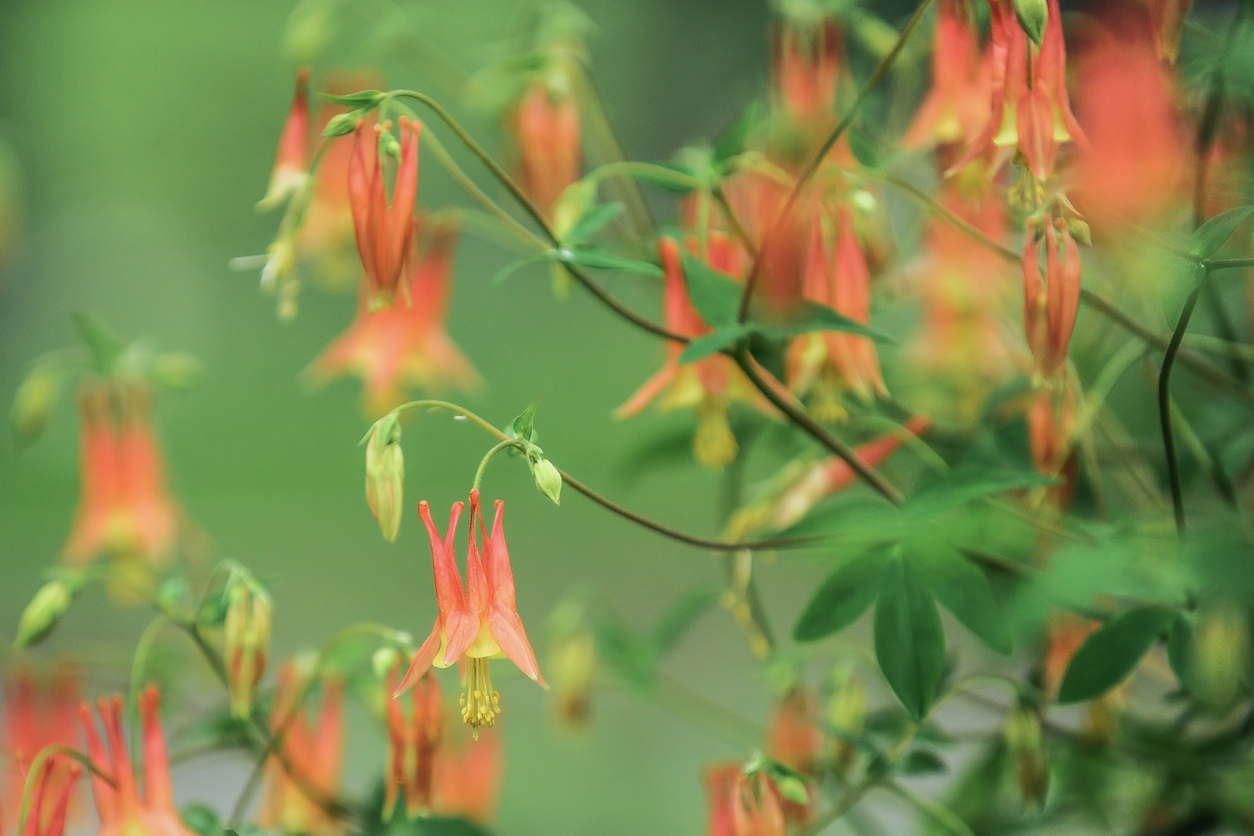
Growing to 4 feet tall under optimum conditions, this columbine has three-lobed leaves and dangling 1- to 2-inch long blooms with yellow petals and red sepals and spurs. Highly attractive to hummingbirds, it generally blooms in late spring to early summer at just the right time to feed those journeying to their summer homes. It also provides sustenance to larvae of the columbine duskywing butterfly. Despite its species name, this columbine is native to areas east of the Rocky Mountains, as well as to Canada.
USDA Plant Hardiness Zones: 3 to 8
Best For: Ideal for woodland gardens or flower beds in partial shade, this columbine self-seeds extensively.
17. Yarrow (Achillea millefolium)

Introduced to the U.S. in colonial days, probably for its uses as a blood-staunching medicinal herb, the escaped yarrow made itself at home and now grows from 1 to 3 feet high throughout much of North America. Attractive to butterflies and bees, the wild form produces spicy-scented ferny foliage and flat clusters of tiny white or pink flowers ideal for drying, from mid-summer through early autumn. It is both deer- and drought-resistant, but can be resistant to being contained.
USDA Plant Hardiness Zones: 3 to 9
Best For: Yarrow thrives in dry, sunny sites such as wildflower meadows.
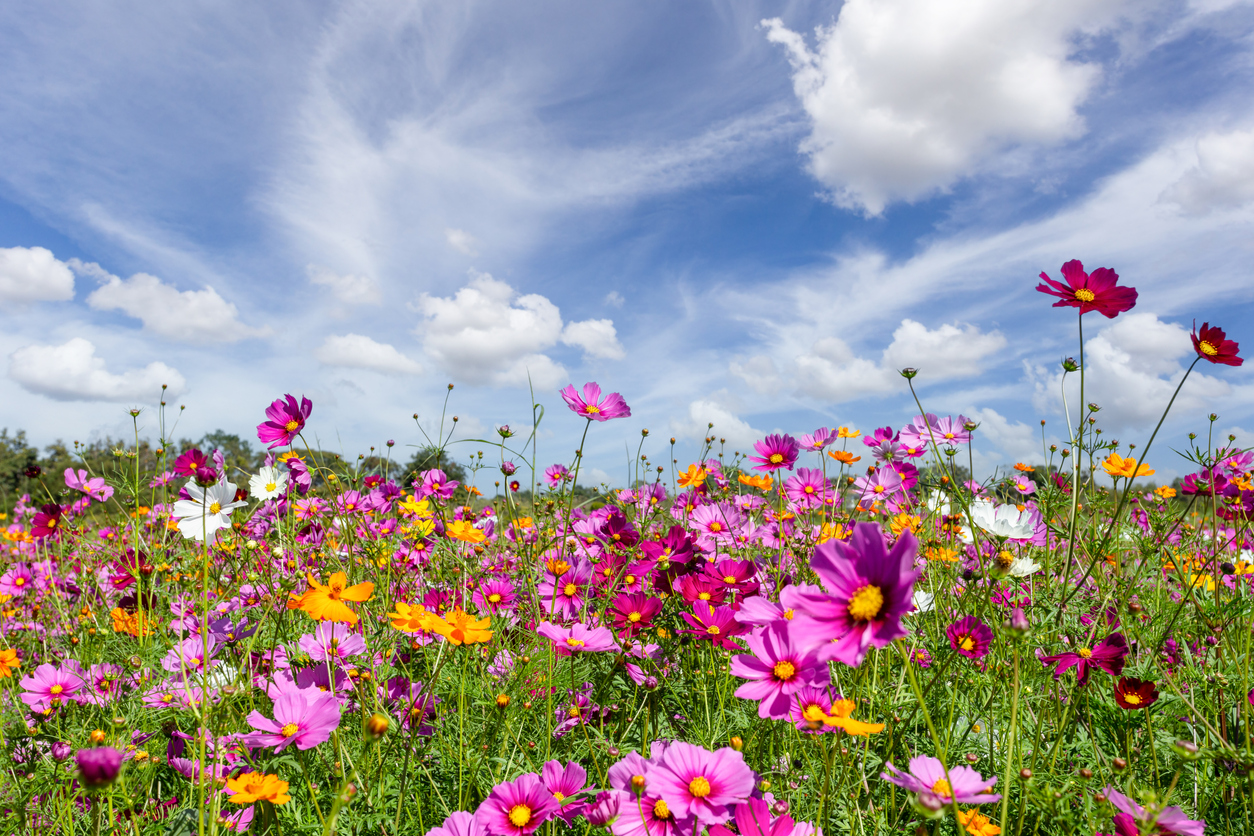
FAQs
Many parts of the world are home to different species of wildflowers. However, countries with vast and diverse ecosystems like Australia, the United States, and South Africa are often celebrated for their rich abundance of wildflower species.
Wildflowers typically grow best from mid-September to late November.
Wildflowers symbolize resilience, beauty, and the untamed spirit of nature.
